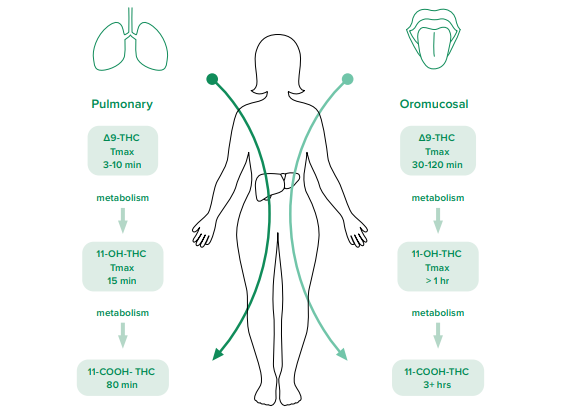How cannabinoids move through the body
The way the cannabinoids THC and CBD move through the body (pharmacokinetics) varies depending upon how it is taken. The duration of their action is influenced by dose size, dose form, and the route of administration – the lungs, mouth, gut or the skin.
Cannabinoids – absorption and distribution
THC and CBD are mainly found in cannabis in their inactive acid form THCA and CBDA. To activate THC and CBD a carboxyl group must be removed by heat. In practice, this so called ‘decarboxylation’ occurs by heating cannabis in a vaporizer, or heating the cannabis extracts before being placed into a solution.
The absorption of inhaled cannabinoids results in a maximum (peak) blood concentration within minutes. Effects in the brain start within seconds to a few minutes, and reach a maximum after 15-30 minutes. They taper off within 2-3 hours.
Absorption is slower when cannabinoids are ingested. Lower, more-delayed peak concentrations occur with oral ingestion. The effects in the brain are delayed for 30-90 minutes, and reach their maximum after 2-3 hours. They last for about 4-12 hours.

Bioavailability of cannabinoids
Bioavailability describes the proportion of a medicine entering blood circulation after administration. The bioavailability of oral THC and CBD is low. By comparison, the inhalation of cannabinoids has been shown to be more effective and reliable compared to oral administration.
THC and CBD are fat soluble (highly lipophilic) compounds which are rapidly absorbed by the lungs. As a result, inhalation is a convenient and fast-acting method of administration, allowing easier titration to the desired dosage and biological effect. About 25% of inhaled THC enters the blood circulation.
The distribution of cannabinoids in the body are ruled by their lipophilicity (their fat solubility) and binding to blood proteins. THC is distributed widely throughout the body, particularly to fatty tissues. The body storage of THC increases with increasing frequency and duration of use.
Metabolism and elimination of cannabinoids
The cannabinoids are mainly metabolised by a collection of liver enzymes called cytochrome P450 (CYP450). The same as many other medicines, these enzymes chemically alter the cannabinoids to remove them from our body (excretion). Besides the liver, other tissues like the heart and lungs are also able to metabolise cannabinoids, albeit to a lesser degree. THC and CBD metabolism follows a similar metabolic route.
Elimination of medicines means their complete removal from our body. Metabolism is the major route for the removal of THC. Unlike THC, a large proportion of CBD is excreted unchanged. Within 5 days of taking a single dose, a total of 80−90% of THC is excreted. The elimination of THC and its metabolites occurs via the faeces and urine. After inhalation, about 25% of the absorbed dose is excreted in the urine; about 65% is eliminated via faeces.
Only very small amounts of THC are excreted unchanged. Less than 5% of an oral dose is found unchanged in the faeces. THC metabolites can be found in the urine and faeces for several weeks. The slow elimination of cannabinoids and their metabolites is due to their slow movement out of our body fat and other tissues back into the bloodstream.
Subscribe to our newsletter
Stay informed with our latest updates by subscribing to our newsletter for exclusive news and compelling content. Rest assured, we prioritize the integrity of your inbox, delivering quality over quantity, with newsletters dispatched judiciously.






